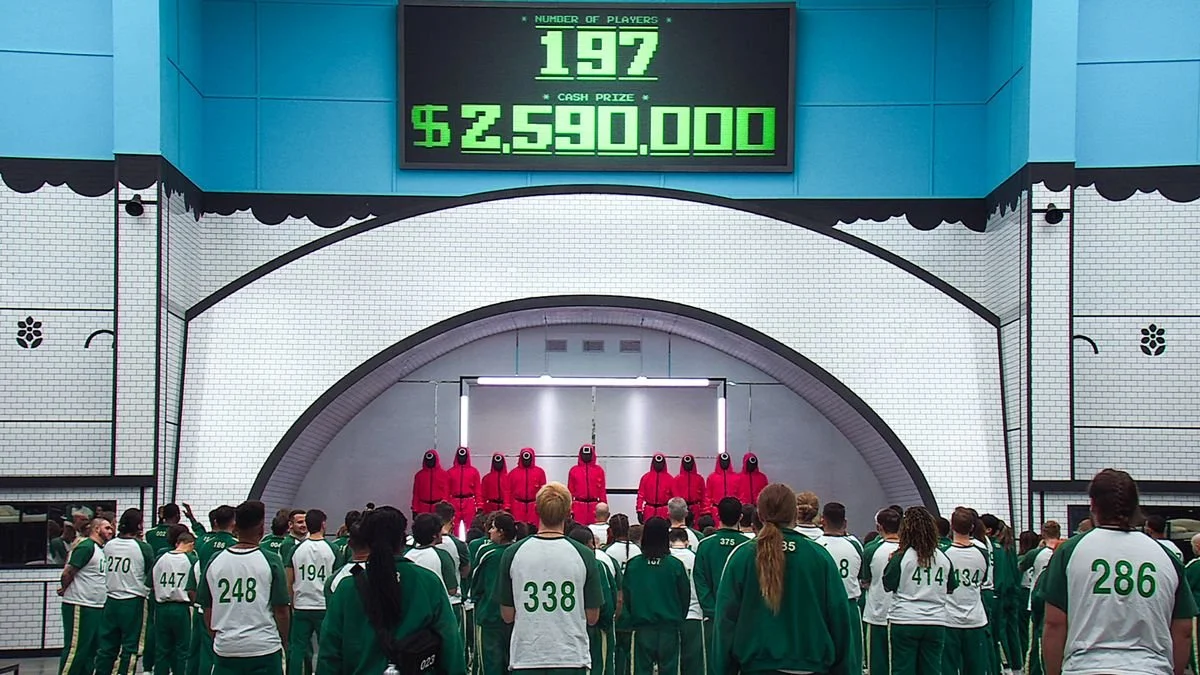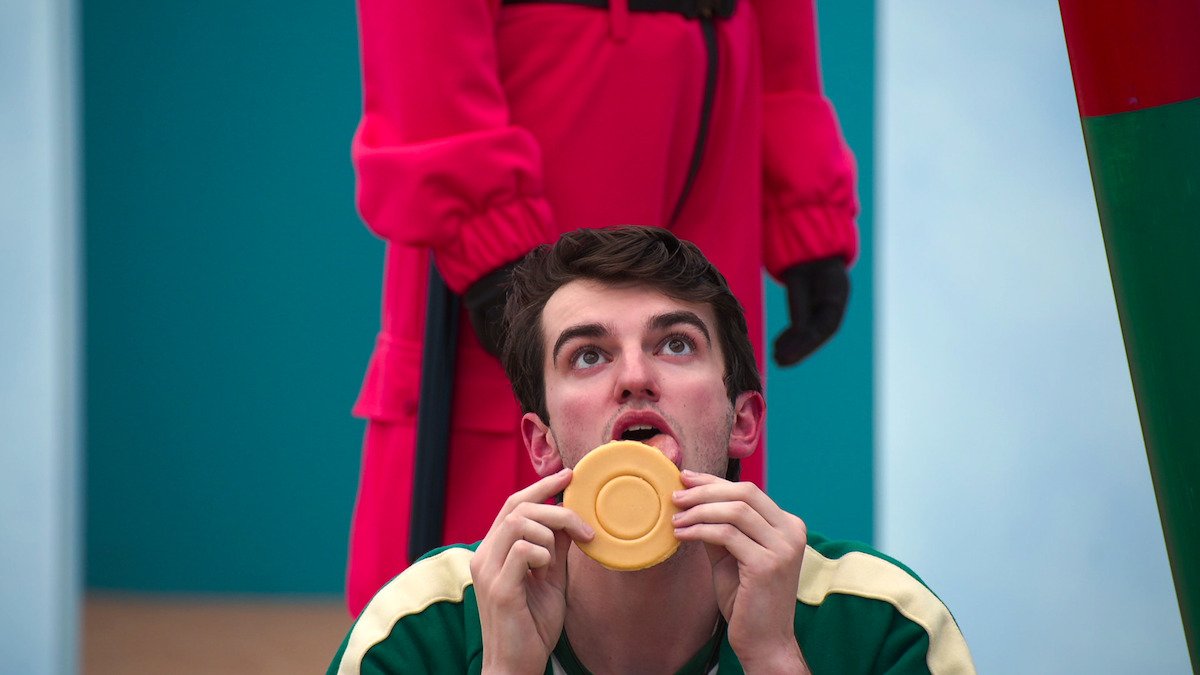Squid Game: The Challenge | Review
In 2021, the South Korean television series Squid Game became arguably Netflix’s greatest success. The show featured hundreds of desperate characters facing financial hardship competing in various children’s games for a chance to win 4.5 billion won. But the catch is, losing a game results in your immediate death. South Korean filmmaker Hwang Dong-hyuk created the show inspired by his family’s own economic struggle in South Korea and the country’s widening class disparity. Squid Game’s mix of compelling characters, critique of capitalism, and easily-replicated games made it an instant hit and worldwide phenomenon. You couldn’t go anywhere without someone mentioning Squid Game. Your friends played the games at parties. People dressed up as the heroes and the villains from the show. Even Mr. Beast, the most popular YouTube content creator, replicated the games from the show! And like any success story in the entertainment industry, all of the wrong lessons were learned, which is why we now have Squid Game: The Challenge, Netflix’s new reality show competition that features 456 players competing for $4.56 USD, the largest single cash prize in reality TV history.
The critiques lobbied against Squid Game: The Challenge—namely, that it exploits desperate people’s attempts to escape the pitfalls of capitalism for entertainment, which the original show critiqued—are certainly warranted. (The show literally recreates the same deadly games from the original series, and even has players wear exploding dye packs to simulate getting shot to death when they’re eliminated.) Especially today, when economic inequality is so stark, with many people being just one missed paycheck away from financial ruin, watching real-life people fight for a chance out of the bottom might leave a bad taste in your mouth. But the same case can essentially be applied to any reality competition show with cash prizes because of how pervasive this inequality is across the globe. I won’t be debating the ethics of watching Squid Game: The Challenge. Whether or not you choose to watch it is a personal decision, but I did watch it. And I have mixed feelings!
You can already tell what the problems with Squid Game: The Challenge are before even starting the show. Just look at that title! “Squid Game: The Challenge.” When I first saw the announcement of the show’s official title, I laughed at how boldly uninspired it was. For a second I actually thought it might have been a crossover with the popular MTV reality competition series The Challenge. Heck, “The Squid Game Challenge” would’ve been a cleaner title! The unoriginality of the title was a harbinger of things to come, as the first two episodes are dedicated to exact recreations of the first two games from the original series: Red Light, Green Light and Dalgona. These episodes are the most boring ones because, as reasonably expected, all of the contestants have seen Squid Game and, therefore, use the same strategies depicted in the show. (There’s nothing compelling about seeing the hundredth contestant lick their dalgona candy!)
Squid Game: The Challenge’s decision to accurately recreate the original series in both form and function results in the reality show’s weakest moments. Sure, casting 456 contestants (the largest cast in reality TV history) is accurate to the original show, but what purpose does it serve? When all 456 contestants are playing Red Light, Green Light, there’s so many people that it’s tough to care for anyone. This is why you don’t see any other reality show competition out there with hundreds of players. There’s no compelling drama to pull from such a large group (not for the show’s lack of trying, as they feature talking heads of select players), which makes you want to fast forward to the point of the competition where it’s down to a dozen or so people left.
Thankfully, after some growing pains, Squid Game: The Challenge improves by episode three, which is when it finally starts to deviate from the original series. In probably the show’s greatest creative decision, the players are tasked to create eight evenly split teams. Everyone assumes the game will be Tug-of-War, based on the order of the games in the original series, resulting in many male-heavy teams. But, to everyone’s surprise, the game turns out to be a large-scale version of the board game Battleship, which involves more strategy (and luck) than brawn. In an instant, the tables have been leveled, and all-male teams no longer have the advantage. It’s thrilling watching Player 182 (TJ), a basketball coach who speaks in motivational cliches, lead his team to success without losing a single teammate. You’re on the edge of your seat watching Player 439 (Bee), a literal genius, and her team barely scrape by. You’re biting your nails with anticipation watching a team decide on one final play that will determine whether or not they all get eliminated. Subverting the contestants’ expectations this way results in the show's best moments. The way the show is able to trick the players to pair up with their in-game besties and compete against one another is clever, and it results in many genuinely emotional payoffs.
The show isn’t always successful in implementing its new challenges, however. At the start of the show, the contestants are told there would be tests that come up that will allow them to earn an advantage or the ability to eliminate another player from the competition. But the first “test” proves to be a disappointment because the two players given the test (Players 101 and 134) don’t actually have to do anything to earn their reward—they’re simply chosen and given the option of giving another player an advantage or eliminating a player. (They choose the latter.) When 101 and 134 fret about being suspected by the remaining players, it ultimately goes nowhere because both players are eliminated within the next episode due to the Dalgona game, not because of any strategy or interpersonal dynamic.
At times, the show tries its best to produce drama, but the players don’t take the bait. In the Vote Test, in which the remaining 70 players must collectively decide on which three players to eliminate, the group doesn’t end up having any fierce debate. Instead, they just vote anonymously. Other times, the players aren’t given enough time for the tests to have dramatic effect. When four players at a time are tasked with coming to a unanimous agreement as to which of their respective groups will receive each of the four Dalgona shapes, there’s no interesting resolution, everyone just runs to a shape and bicker before all being eliminated when their two-minute timer runs out. In the Phone Test, in which a player answers a phone and is given two minutes to convince someone else to pick up the phone in order to avoid elimination, is anticlimactic, both because the player who originally picks up the phone (Player 198) doesn’t come up with a convincing strategy and because of how short the allotted time is.
In order to cut 436 players down to a more manageable group, the show relies on too many games that are based on luck. The Jack-in-the-Box Test (in which five volunteers select a jack-in-the-box, each with a hidden advantage or instant-elimination) and Die Test (in which players can nominate themselves or another player for elimination, and if they roll a six the nominated player is eliminated) rely so much on chance, it’s heartbreaking in an unsatisfying way to see likable players we are just getting to know be instantly eliminated. This is also why the finale is so underwhelming. While it’s not surprising the game show doesn’t copy the original show’s final game (the titular Squid Game) because it involves physical altercations, having the winner be determined by a game of Rock, Paper, Scissors, instead of one that requires more strategy, feels anticlimactic. (Even Mr. Beast wasn’t able to find a strong alternative to the final game!)
Viewing Squid Game: The Challenge in its entirety, it’s clear the show is an act of brand extension, relying on Squid Game’s built-in audience to bring in viewers (and it worked, the series has consistently topped Netflix’s Top 10 charts). Yet, ironically, the show is often at its best when it deviates from the original show, to the point where it would have been a much better show if it wasn’t related to Squid Game at all, and therefore not be so beholden to the original show’s elements. (The game show’s production company, Studio Lambert, has a track record of producing highly successful and binge-worthy reality competition shows, like Netflix’s The Circle or Peacock’s The Traitors.) The game show has already been renewed for a second season, and since the original Squid Game hasn’t released its second season yet, Squid Game: The Challenge has the opportunity to become its own thing and, hopefully, a better show.











